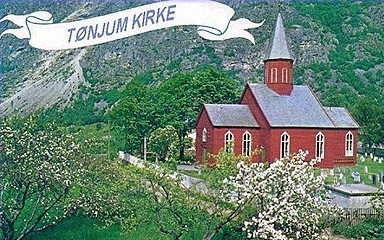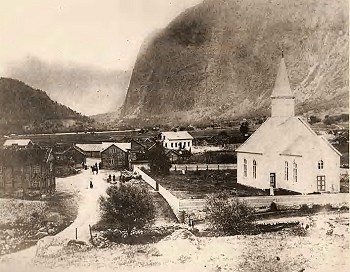
Tønjum Kyrkje 1999
Photo courtesy of Jan Eri
The following are excerpts from two Norwegian publications regarding the history of Tønjum Kyrkje. Translation by Jan Eri.
(1) Brochure from 150th anniversary (new church) in 1982:
"One doesn’t know exactly when the first Tønjum church with the old name "Tunjynja Kirkja i Lærdal" was built. Based on the look of the ornaments around the entrance and some coins found there, the experts believe it must have been around 1205. This stavechurch blew down on January 12th, 1823. An idea about how it looked can only be based on the few parts of it that still exist (in the Bergen Museum). It is believed that it was a three-shipped stavechurch of the same kind as the Borgund church, with semi-circled choir (apsis). it took quite some time before th enew church was built. The reason is said to be that the vicar at that time wanted to place the new church for Tønjum
and Hauge on Øvre Eri. Also, he didn't approve of the drawings for the new church. Finally, the only crosschurch in Sogn was built at Tønjum by church owners Torger Halvorsen Næs and Halvor Olsen Raae. Tøger Churchbuilder from Hafslo did the work. The church was consecrated by Bishop Neumann on September 20th, 1832. The choir was finished in 1837 and the church was then painted on the inside. On July 3rd, 1864, the first exterior painting of the church was finished, this was paid for by Lærdal County. The tower was extended and wainscotted in 1871, since then the church has had the shape of today. The largest change since then was in 1963 when the church was painted red (see photo below) after recommendation of consultant Skalan in Bergen. This was not a popular choice, and plans were made among people to paint it white again based on voluntary work. With the steady and careful mind of the Lærdøl, it's hardly a surprise that this
demonstration-operation never happened. In 1964-65, it was put antique windows in the church. In 1965, electrical heating was installed. The equipment in the church is supplemented by gifts from anonymous organizations and individuals, as well as the flower fund and the church fund. A sad thing is that the church at its 150th anniversary had no working organ. The old organ brought here in 1956 no longer works."

Postcard courtesy of Terje Hagen and Rune Sanden
(2) Translation from "Helg og Kvardag" No. 3 , 1995 a church magazine for Lærdal..
"The stavechurch on Tønjum was from 1100 or 1200. It was bigger than the one on Borgund. In 1826 the tower blew down and it was never put up again. On historic museum in Bergen there is some parts from this church...
All the portals are saved, both left and right side from the four portals and dragons. A door ring from 1200 in forged iron, with the head of a dragon and a human. The ring has the Latin inscription:
Ave Maria gracia plena dominus tecum benedicta tu in muleribus.
Two procession staves with the candlesticks on the top, made of oak. They are made in Germany around 1500. A headstone cut in limestone. It is 184cm long, 90cm wide, and 11cm high. On the stone there is an outline of a priest holding a chalk and a disk. If this is meant to be a priest of the Tønjum church, the chalk and disk must be part of the communion silver which still exists."
Although these publications don't seem to agree on when the original church was actually destroyed, I think we can all agree that it is a very interesting read.
Thanks for the information, Jan!

Photo courtesy of Iris Westerberg
As you can see from the photo on the Tinjum Lineage page, the church is red once again. The above photograph of the Tønjum Kirke was kept in a trunk by Iris's mother. Her parents were married in the church in 1869, so the photo was a keepsake to her.
Thanks for sharing, Iris!
If you discover a connection with any of the families we
are researching, please email us.
Thanks for visiting The Tønjum Church History Page.
Please come back again soon!
Leaves and Branches
Researching our roots
Email: lrtjohansen@gmail.com
All material and graphics on this site copyright 2002 by Lorene Tinjum Johansen.
You may download any portion for your personal use, upon permission.